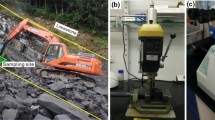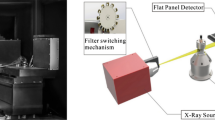Abstract
In past couple of decades, scanning electron microscope and digital image correlation has been extensively used to investigate the microcrack propagation in rocks. Only recently, X-ray computed tomography (CT) scans were used for more detailed understanding of the physico-mechanical behavior of rock specimens. In current study, the deformational behavior of bedded Marcellus shale was studied through the changes in the geometry of microcracks. Quasi-static triaxial tests at three successive levels of differential stress were conducted on cylindrical-shaped shale specimens at a confining pressure of 6.89 MPa. Mineralogical analysis indicated the homogenous composition of specimen, however, triaxial tests resulted varying modulus of stiffness at similar confining pressure. The X-ray CT scanned images of specimens prior to the triaxial stress showed the significant density of pre-existing microcracks. During triaxial tests, the successive levels of differential stress influenced the geometry of pre-existing microcracks. The differential stress equivalent to 55% and 65% of the differential strength significantly closed the pre-existing microcracks. However, differential stress equivalent to 70% of the differential strength increased the density of microcracks. The orientation of the bedding plane only influenced the direction of microcrack propagation. The perpendicular-bedded specimen experienced significant microcrack propagation in the axial direction, while the parallel-bedded specimen experienced significant increase in the aperture of microcracks.



















Similar content being viewed by others
References
Alejano LR, Alonso E (2005) Considerations of the dilatancy angle in rocks and rock masses. Int J Rock Mech Min Sci 42:481–507
Almisned OA, Al-Quraishi A, Al-Awad MN (2017) Effect of triaxial in situ stress and heterogeneities on absolute permeability of laminated rocks. J Pet Explor Prod Technol 7(2):311–316
Arena A, Piane CD, Sarout J (2014) A new computational approach to cracks quantification from 2D image analysis: application to micro-cracks description in rocks. Comput Geosci 66:106–120
Arganda-Carreras I et al (2017) Trainable Weka Segmentation: a machine learning tool for microscopy pixel classification: Bioinformatics (Oxford Univ Press) Bioinformatics btx 180, PMID 28369169
ASTM (2014) ASTM D7012-14e1: standard test methods for compressive strength and elastic moduli of intact rock core specimens under varying states of stress and temperatures. ASTM International: West Conshohocken, PA
ASTM (2016) ASTM D5731 – 16: standard test method for determination of the point load strength index of rock and application to rock strength classifications. ASTM International: West Conshohocken, PA
ASTM (2019) ASTM D4543-19: Standard practices for preparing rock core as cylindrical test specimens and verifying conformance to dimensional and shape tolerances. ASTM International: West Conshohocken, PA
Batzle ML, Simmons G, Siegfried RW (1980) Microcrack closure in rocks under stress: direct observation. J Geophys Res 85(B12):7072–7090
Bay BK (2008) Methods and applications of digital volume correlation. J Strain Anal Eng Des 43(8):745–760
Bernasconi A (2005) Structural analysis applied to epilepsy. In: Kuzniecky RI, Jackson GD (ed) Magnetic resonance in epilepsy: neuroimaging techniques, 2nd edn. New York, NY, p 464
Bieniawski ZT (1967) Mechanism of brittle failure of rock. Part I: theory of fracture process. Int J Rock Mech Min Sci Geomech Abstr 4(4):395–406
Bobko CP (2008) Assessing the mechanical microstructure of shale by nanoindentation: the link between mineral composition and mechanical properties. PhD dissertation, Cambridge, Massachusetts Institute of Technology, Massachusetts
Brantut N (2015) Time-dependent recovery of microcrack damage and seismic wave speeds in deformed limestone. J Geophys Res Solid Earth 120:8088–8109
Brooks Z et al (2010) A nanomechanical investigation of the crack tip process zone. In: Proceedings of the 44th U.S. rock mechanics symposium, American Rock Mechanics Association, Alexandria, VA
Budiansky B, O’Connell RJ (1976) Elastic moduli of a cracked solid. Int J Solids Struct 12(2):81–97
Campbell CV (1967) Lamina, laminaset, bed and bedset. Sedimentology 8(1):7–26
Cnudde V, Boone MN (2013) High-resolution X-ray computed tomography in geosciences: a review of the current technology. Earth Sci Rev 123:1–17
Costin LS (1983) Microcrack model for the deformation and failure of brittle rock. J Geophys Res Atmos 88(B11):9485–9492
Crandall D, Moore J, Brown S, Martin K, Mackey P, Paronish T, Carr T, Bowers C (2018) Computed tomography scanning and geophysical measurements of core from the Coldstream 1 MH Well. NETL-TRS-5-2018, NETL Technical Report Series, U.S. Department of Energy, National Energy Technology Laboratory, Morgantown, WV
Cui Z, Han W (2018) In situ scanning electron microscope (SEM) observations of damage and crack growth of shale. Microsc Microanal 24(2):107–115
Cusatis G, Jin C, Li W (2015) Experimental characterization of Marcellus shale. SEGIM Internal Report No. 15-08/478 E. Center for Sustainable Engineering of Geological and Infrastructure Materials, Northwestern University
Deng H, Fitts JP, Peters CA (2016) Quantifying fracture geometry with X-ray tomography: technique of iterative local thresholding (TILT) for 3D image segmentation. Comput Geosci 20:231–244
Ferreira T, Rasband W (2012) ImageJ User Guide–IJ 1.46r, National Institute of Health, Bethesda, MD
Fredrich JT, Di Giovanni AA, Nobel DR (2006) Predicting macroscopic transport properties using microscopic image data. J Geophys Res 111(B3):14
Gnos E et al (2010) Sayh al Uhaymir: a new martian meteorite from the Oman desert. Meteor Planet Sci 37(6):835–854
Griffiths L, Heap MJ, Baud P, Schmittbuhl J (2017) Quantification of microcrack characteristics and implications for stiffness and strength of granite. Int J Rock Mech Min Sci 100:138–150
Guo D et al (2014) Salt and pepper noise removal with noise detection and a patch-based sparse representation. Adv Multimed 2014:14
Gupta N (2019) Fundamental mechanism of time-dependent failure in shale. Graduate theses, dissertations, and problem report, West Virginia University. https://researchrepository.wvu.edu/etd/7445
Gupta N, Mishra B (2017). Creep characterization of Marcellus shale. In: Proceedings of the 51st U.S. rock mechanics symposium, American Rock Mechanics Association, Alexandria, VA, p 4
Gupta N, Das D, Mishra B (2018) Analysis of crack propagation in shale using microscopic imaging techniques. In: Proceedings of the 52nd US rock mechanics symposium, American Rock Mechanics Association, Alexandria, VA, p 6
Hoek E, Brown ET (1980) Underground excavations in rock. CRC Press, Boca Raton
Jaeger JC, Cook NGW (1976) Fundamentals of rock mechanics. Chapman and Hall, London
Jia L, Chen M, Jin Y (2014) 3D imaging of fracture in carbonate rocks using X-ray computed tomography technology. Carbonate Evaporites 29(2):147–153
Kallu R, Pedram R (2015) Correlations between direct and indirect strength test methods. Int J Min Sci Technol 25(3):355–360
Koeberl C et al (2002) High-resolution X-ray computed tomography of impactites. J Geophys Res 107:19-1–19-9
Kranz RL (1983) Microcracks in rocks: a review. Tectonophysics 100(1–3):449–480
Kuila U et al (2011) Stress anisotropy and velocity anisotropy in low porosity shale. Tectonophysics 503(1–2):34–44
Labuz JF, Shah SP, Dowding CH (1987) The fracture process zone in granite: evidence and effect. Int J Rock Mech Min Sci Geomech Abstr 24(4):235–246
Latief et al (2017) The effect of X-ray micro computed tomography image resolution on flow properties of porous rocks. J Microsc 266(1):69–88
Lenoir N et al (2007) Volumetric digital image correlation applied to X-ray microtromography images from triaxial compression tests on argillaceous rock. Strain 43(3):193–205
Li D, Ngai L, Wong Y (2013) The Brazilian disc test for rock mechanics applications: review and new insights. Rock Mech Rock Eng 46:269–287
Liu B, Wang BS, Ji WG (2001) Closure of micro cracks in rock samples under confining pressure. Chin J Geophys 44(3):419–426
Maire E, Withers PJ (2014) Quantitative X-ray tomography. Int Mater Rev 59(1):1–43
Mark C, Molinda G (2007) Development and application of coal mine roof rating (CMRR) In: Proceedings of the international workshop on rock mass classification in underground mining, NIOSH, Pittsburgh, PA, p 162
Martin CD (1993) The strength of massive Lac du Bonnet granite around underground opening. PhD dissertation, University of Manitoba
Mavko GM, Nur A (1978) The effect of nonelliptical cracks on the compressibility of rocks. J Geophys Res 83(B9):4459–4468
Mogi K (2006) Experimental rock mechanics. CRC Press, London
Mohapatra S (2012) Development and quantitative assessment of a beam-hardening correction model for preclinical micro-CT. MS dissertation, University of Iowa
Molinda G, Mark C (1994) Coal mine roof rating (CMRR): a practical rock mass classification for coal mines. Information circular 9387. U.S. Department of the Interior, Bureau of Mines, Washington, DC
Morgan SP, Einstein HH (2014) The effect of bedding plane orientation on crack propagation and coalescence in shale. In: Proceedings: 48th U.S. rock mechanics symposium, Minneapolis, MN, 1–4 June
Murphy MM (2016) Shale failure mechanics and intervention measures in underground coal mines: results from 50 years of ground control safety research. Rock Mech Rock Eng 49(2):661–671
Niandou H et al (1997) Laboratory investigation of the mechanical behavior of Tournemire shale. Int J Rock Mech Min Sci 34(1):3–16
Nur A, Simmons G (1970) The origin of small cracks in igneous rocks. Int J Rock Mech Min Sci Geomech Abstr 7(3):307–314
O’Connell RJ, Budiansky B (1974) Seismic velocities in dry and saturated cracked solids. J Geophys Res 79(35):5412–5426
Peng SS (2015) Topical areas of research needs in ground control: a state of the art review on coal mine ground control. Int J Min Sci Technol 25(1):1–6
Popova O (2017) Marcellus shale play: geology review. Independent Statistics and Analysis, U.S. Energy Information Administration
Promentilla MAB et al (2009) Quantification of tortuosity in hardened cement paste using synchrotron-based X-ray computed microtomography. Cem Concr Res 39(6):548–557
Rodriguez R et al (2014) Imaging techniques for analyzing shale pores and minerals. U.S. department of energy, national energy technology laboratory, Morgantown, WV
Roen JB (1984) Geology of the Devonian black shales of the Appalachian Basin. Org Geochem 5(4):241–254
Rowe T et al (2001) Forensic palentology: the archaeoraptor forgery. Nature 410:539–540
Schindelin J, Arganda-Carreras I, Frise E et al (2012) FIJI: an open-source platform for biological-image analysis. Nat Methods 9(7):676–682
Sellars E, Vervoort A, Cleyenenbreugel JV (2003) 3D visualization of fractures in rock test samples, simulating deep level mining excavations, using X-ray computed tomography. Geol Soc Lond Spec Public 215:69–80
Simmons G, Richter D (1976) Microcracks in rock. In: Strens RGJ (ed) The physics and chemistry of minerals and rocks. Wiley, New York, pp 105–137
Sprunt E, Brace WF (1974) Direct observation of microcavities in crystalline rocks. Int J Rock Mech Min Sci Geomech Abstr 11:139–150
Tapponnier P, Brace WF (1976) Development of stress-induced microcracks in Westerly granite. Int J Rock Mech Min Sci Geomech Abstr 13:103–112
Voorn M, Exner U, Rath A (2013) Multiscale Hessian fracture filtering for the enhancement and segmentation of narrow fractures in 3D image data. Comput Geosci 57:44–53
Waarsing JH, Day JS, Weinans H (2004) An improved segmentation method for in vivo microCT imaging. J Bone Miner Res 19(10):1640–1650
Wang Q, Song X, Jiang Z (2013) An improved image segmentation method using 3D region growing algorithm. In: Proceedings of the international conference on information science and computer applications, Atlantis Press, Paris, France, p 5
Wu Z, Wong HS, Buenfeld NR (2014) Effect of confining pressure and microcracks on mass transport properties of concrete. Adv Appl Ceram 113(8):485–495
Xradia (2010) MicroXCT-200 and MicroXCT-400 User’s guide. Version 7.0, Revision 1.5
Yang X et al (2016) Experimental study of high-temperature fracture propagation in anthracite and destruction of mudstone from coalfield using high-resolution microfocus X-ray computed tomography. Rock Mech Rock Eng 49(9):3723–3734
Zuiderveld K (1994) Contrast Limited adaptive histogram equalization. In: Graphics gems IV, Academic Press Professional Inc., pp 474–485
Acknowledgements
Financial support for this work was provided by the Centers for Disease Control and Prevention-National Institute of Occupational Health and Safety (No. 200- 2016-92,214). The authors would like to thank Dr. Dustin Crandall, Sarah Brown and Johnathan E. Moore at National Energy Technology Laboratory (NETL) Morgantown for X-ray CT Scan of shale specimens. The authors would also like to thank Dr. Karen Martin and Sarah McLaughlin from Animal Models and Imaging Facility (AMIF) of West Virginia University (WVU) to provide the access of Bruker CTAn image analysis software.
Author information
Authors and Affiliations
Corresponding author
Additional information
Publisher's Note
Springer Nature remains neutral with regard to jurisdictional claims in published maps and institutional affiliations.
Rights and permissions
About this article
Cite this article
Gupta, N., Mishra, B. Experimental Investigation of the Influence of Bedding Planes and Differential Stress on Microcrack Propagation in Shale Using X-Ray CT Scan. Geotech Geol Eng 39, 213–236 (2021). https://doi.org/10.1007/s10706-020-01487-z
Received:
Accepted:
Published:
Issue Date:
DOI: https://doi.org/10.1007/s10706-020-01487-z




